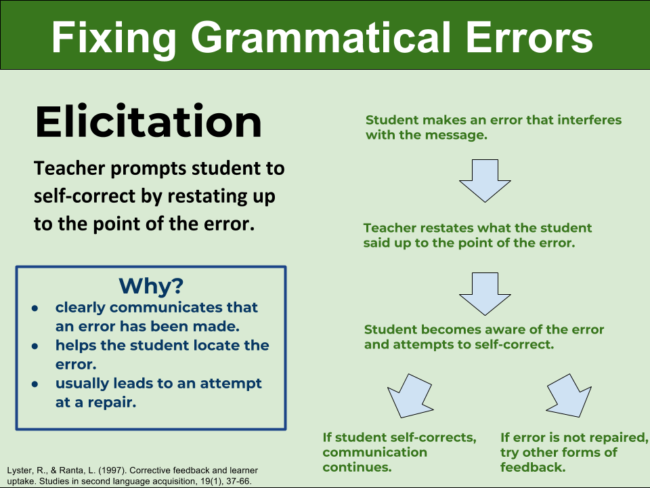
As language teachers, we are completely accustomed to hearing our students make errors in their oral production. The errors vary in severity and their potential to cause miscommunication. For example, when I was learning Spanish and working in retail, I once asked a Spanish-speaking woman repeatedly for her recipe instead of her receipt. Her confusion gave me a clear signal that I wasn’t asking for the right thing, but unfortunately I didn’t have a teacher present to elicit the correct word.
Different teachers may choose to correct all errors, only some, or none. I think we can all agree that our students need feedback on their oral language production. While our students and their brains are quite amazing, they do need some guidance to continue building their proficiency.
In their research on oral corrective feedback in language classrooms, Lyster and Ranta (1997) have identified six types of oral corrective feedback. Here are some basic definitions:
-
- Recast- restate what the student said with the correct form.
- Clarification requests– teacher says something like “Huh?” or “I beg your pardon?”
- Explicit correction– Give the student and correct form and tell them directly what was incorrect.
- Metalinguistic feedback– Teacher asks questions or makes comments about the utterance.
- Repetition- Teacher repeats incorrect phrase with emphasis/raised intonation on the error.
- Elicitation- Teacher prompts student to self-correct by restating up to the point of the error.
Which response is the least effective?
In this study, recasts were both the most used error correction strategy and the least effective in leading to student uptake. Student uptake is the idea that feedback leads to the student recognizing the presence of an error and attempting to make a repair. In fact, recasts (a correct restatement of the student’s utterance) led to NO uptake 69% of the time.
The other 31% of recasts led to an attempt of a repair, but none of these repairs were student generated since the teacher provided the correct form. Conversely, feedback identified as elicitation led to student uptake 100% of the time, which means the student always realized he made an error and possibly attempted to correct it.
Recasts and other types of feedback should not be abandoned as they can be useful. In a more recent study by Lyster, Saito, and Sato (2013), the researchers concluded that the most effective teachers use a variety of feedback techniques considering factors such as targets, context, student age, proficiency, etc. However, since elicitation is a less common yet effective strategy, we will focus today on how to use it in the classroom.
Elicitation is an oral corrective feedback strategy that:
- clearly communicates that an error has been made.
- helps the student locate the error.
- usually leads to an attempt at a repair.
How to elicit corrections
To employ elicitation, the teacher repeats the student’s utterance up to the point of the error was made, and then stops to give the student time to think and respond. Here are examples:
-Working with plurals ending in –s and –es, I pronounce the word up to the point of the error:
Target: plural of the word ‘octopus’
- S: octopus
- T: octopus…
- S: octopuses
Target: plural of the word ‘shoe’
- S: shoeses.
- T: shoe…
- S: shoes.
Target: verb tense
- S: I don’t got it.
- T: I don’t…
- S: I don’t have it.
Target: appropriateness of words
- T: Where is it?
- S: In the chicken!
- T: Where? (The teacher asks for clarification.)
- S: In the chicken!
- T: In the… (elicitation)
- S: In the kitchen!
How often should teachers give oral corrective feedback?
Generally, if a speaking activity is focused on communication, it stands to reason that errors which do not interfere with communication do not need to be corrected, while errors that cause miscommunication should be corrected. A teacher would not want to transform a speaking activity into a grammar activity by attempting to correct every error, which would be discouraging to students probably impossible to accomplish.
Listen to the students. Are they all making the same error? If so, they need more modeling and input rather than corrective feedback. Is the error in a structure (or pronunciation, vocabulary,etc.) that has been practiced extensively? Maybe the students need more explicit forms of feedback.
So, the next time you hear a student makes an oral error that interferes with communication, and you’re tempted simply to repeat the sentence with the correct form, try elicitation or another feedback strategy instead. A teacher can’t have too many tools for giving feedback!
References:
Lyster, R., & Ranta, L. (1997). Corrective feedback and learner uptake. Studies in second language acquisition, 19(1), 37-66.
Lyster, R., Saito, K., & Sato, M. (2013). Oral corrective feedback in second language classrooms. Language teaching, 46(1), 1-40.

Jeffrey Karr is a K-5 English Language Learners Instructional Specialist in Springfield Public Schools and Spanish Instructor at Missouri State University in Springfield, MO.

